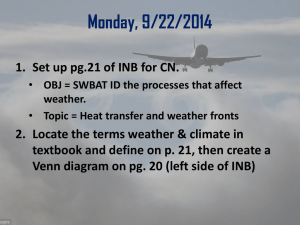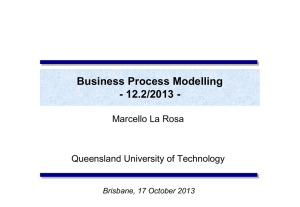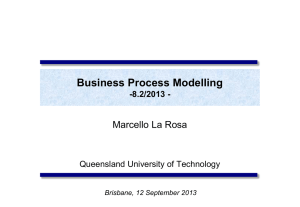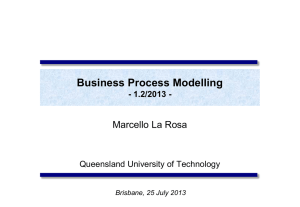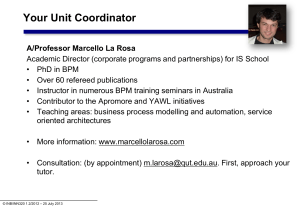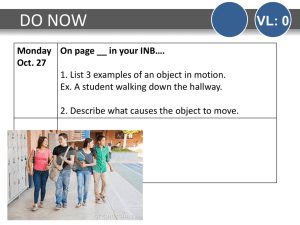Process Engineering - Fundamentals of BPM
advertisement
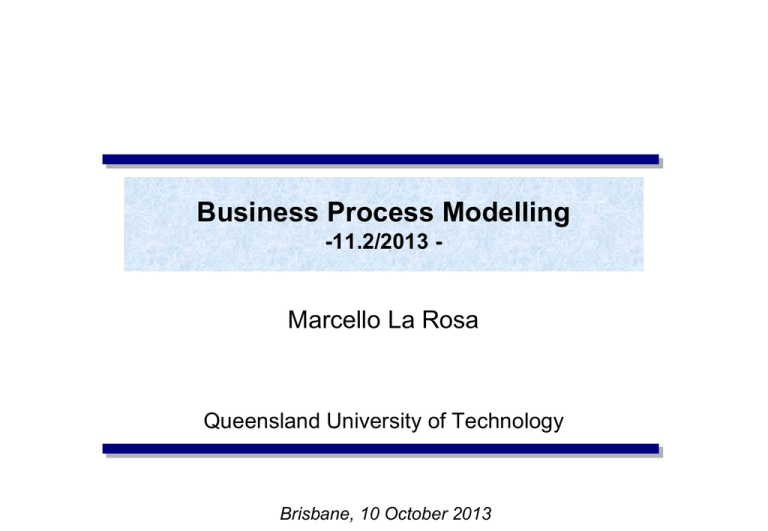
Business Process Modelling -11.2/2013 - Marcello La Rosa Queensland University of Technology Brisbane, 10 October 2013 Assignment 1 Results 60 50 40 30 20 10 0 1 2 3 4 5 -10 Assignment 1 INN © INB/INN320 11.2/2013 – 10 October 2013 Assignment 1 INB 6 7 Assignment 1 – Common mistakes Models: • Generally, good to high-quality models, but • Low labelling quality (event labels missing; message labels missing; issues with activity labels) • Improper vertical modularization (low-level model inconsistent with high-level one; sub-process construct not used) Format: • Inconsistencies across sections (too good vs too bad models; good vs bad English) • Introduction / conclusion – often too short, often lacking motivation of topic (why is this interesting? why do we do what we do?) • Citations of existing literature (wrong or missing references) © INB/INN320 11.2/2013 – 10 October 2013 BPM Lifecycle Process identification Process Process architecture architecture Conformance Conformance and and performance insights performance insights Process discovery As-is As-is process process model model Process monitoring and controlling Process analysis Executable Executable process process model model Process implementation © INB/INN320 11.2/2013 – 10 October 2013 Insights Insights on on weaknesses weaknesses and and their their impact impact To-be To-be process process model model Process redesign Process Identification What? 1. Define an organization’s business processes 2. Establish criteria to prioritize the management of these processes Why? 1. Understand the organization 2. Maximize value of BPM initiatives Output: Process Architecture – Captures business processes and their scope – Serves as a framework for defining priorities and scope of subsequent BPM phases (e.g. modelling, redesign and automation). © INB/INN320 11.2/2013 – 10 October 2013 Process Identification Steps 1. Designation phase – Enumerate main processes – Determine process scope: boundaries (horizontal and vertical) and interrelationships (order and hierarchical) 2. Evaluation phase (a.k.a. Process Selection) Evaluate processes’ – Alignment with strategic objectives – Health (e.g. performance, compliance, sustainability…) – Culture & politics – Feasibility to being successfully improved – Risk of not improving them After Davenport (1993) © INB/INN320 11.2/2013 – 10 October 2013 Process Enumeration • There is no “number fits all” - it really depends on organization’s domain and size • Trade-off: – ensuring process scope is manageable, since – process scope determines potential impact © INB/INN320 11.2/2013 – 10 October 2013 7 Process Scoping • Processes are interdependent Insights into interrelations required – Horizontal: upstream – downstream processes – Vertical: root (a.k.a. main) processes – sub-processes • Processes change over time – identification should be exploratory and iterative – improvement opportunities are time-constrained Process Architecture © INB/INN320 11.2/2013 – 10 October 2013 Process Architecture © INB/INN320 11.2/2013 – 10 October 2013 Architecture: high level picture of an organization Suppliers & Partners Labor Markets people General Environmental Influences: Local and global economies, government regulations, and social trends Customers & Owners information & dividends Your Organization Shareholders requests for new products Capital Markets capital sales contacts Research Community Markets marketing contacts Customers Customers orders technology products & services delivered Vendors materials support requests Competitors competitive products After Rummler and Brache (1990) © INB/INN320 11.2/2013 – 10 October 2013 “Process” Architecture Value chains Suppliers & Partners Labor Markets people The US and world economies, government regulations, and social trends BPT Delivery Deliver Packages via Air & Ground Capital Markets Research Community capital technology Manage Outsourced Supply Chain Operations information & dividends Shareholders Southern US and Central America Individuals & Businesses that want on site pickup & delivery Southern US and Central America Businesses that want to Outsource Delivery Operations Finance Supply Chain Operations Vendors Customers & Owners Businesses that need transport financing materials UPS, FedEx. US & Mexican Postal Services © INB/INN320 11.2/2013 – 10 October 2013 competitive products Components of a Process Architecture Core Processes Customers / Owners Suppliers / Partners Management Processes Support Processes © INB/INN320 11.2/2013 – 10 October 2013 After Porter Core, Management and Support Processes Management processes provide direction, rules and practices Establish Sourcing Procedure Core processes generate value as they are directly linked to external customers Sign Contracts Plan Vendors Process Fill Order Process Receive Order Support processes provide resources to be used by other processes Approve Order Stock Supplies Fill Order Reorder Supplies Process Receive Supplies © INB/INN320 11.2/2013 – 10 October 2013 Evaluate Vendors Deliver Order Order Supplies Process Architecture Example Television New Zealand © INB/INN320 11.2/2013 – 10 October 2013 Process Architecture Example WA Water Corporation © INB/INN320 11.2/2013 – 10 October 2013 Process Architecture Example An insurance company Strategic Management Investor Relations Corporate Development Management Processes Risk Assessment and Management Market Development Sales and Marketing Underwriting Management Policy Servicing Claims Management Collections and Disbursement Asset Management Core Processes Finance/ Treasury Legal/ Audit Enabling Processes © INB/INN320 11.2/2013 – 10 October 2013 Reinsurance IT HR Selected questions for scoping a process • If Process Architecture already in place: where does the process fit into the Process Architecture? • On what level is the unit of analysis, i.e. end-to-end process, procedure or operation? • What are the previous/subsequent processes and what are the interfaces to them? • What variants does this process have? • What underlying processes describe elements of this process in more detail? © INB/INN320 11.2/2013 – 10 October 2013 Various techniques to scope a process • Identify relevant stakeholders and objectives, e.g. via a Stakeholder-Objectives Matrix • Identify relevant context, e.g. via a SIPOC (Suppliers, Inputs, Process, Output, Customers) Diagram • Identify relevant process boundaries, e.g. via a Case/Function Matrix • Identify relevant guides and enablers, e.g. via an IGEO (Input/Guides/Enablers/Outputs) Diagram • A combination of the above © INB/INN320 11.2/2013 – 10 October 2013 Identify Process Stakeholders – Process owner, responsible for the effective and efficient operation of the process being modeled – Primary process participants, i.e. those who are directly involved in the execution of the process under analysis – Secondary process participants, i.e. those who are directly involved in the execution of the preceding or succeeding processes © INB/INN320 11.2/2013 – 10 October 2013 Identify Process Objectives • Primary (hard) process objectives – Time, cost, quality (minimise, maximise) – satisfaction, compliance, flexibility, predictability • Secondary process objectives – To purchase goods, to hire new staff members • Accompany with appropriate process metrics • Let involved stakeholders define their priorities © INB/INN320 11.2/2013 – 10 October 2013 Guidelines to identify horizontal boundaries 1. 2. 3. 4. 5. 6. 7. 8. Change of flow object in the process Change of multiplicity of flow object in the process Change of transactional state Process contains logical separation in time Process contains logical separation in space Process contains logical separation in other dimension Follow scope in reference model (see later) Based on functions/cases covered © INB/INN320 11.2/2013 – 10 October 2013 A stepwise method to build process architectures Case/function matrix (see Chap. 2 of textbook) © INB/INN320 11.2/2013 – 10 October 2013 Identify vertical boundaries: typical artefacts in a Process Hierarchy Value chains A major line of business, has direct effect on a company's business results and strategic importance. Stays at a high level. For example: presentation of a product to the market. (Root/Main) Processes Processes build up value chains and mutually affect each other. For example: market research. Sub-processes Initial focus of Process Enumeration Sub-processes build up processes. They involve multiple activities and can be layered on different levels of granularity (i.e. sub-sub-processes). For example: sales operation, preparation of sales budget, reception of customer orders. Process tasks Process tasks build up processes and sub-processes. These tasks are conducted by one or more individuals within the same function. For example: reception of customer orders involves review of these orders and incorporating them into the system. © INB/INN320 11.2/2013 – 10 October 2013 Hierarchy Example: British Telecom Model structure, methodology and modelling standards Level A Business Activities Level B Process Groupings Level C Core Processes Level D Business Process Flows Level E Operational Process Flows Level F Detailed Process Flows Operations Levels Process Levels Business Levels Meta Level Defines business activities Distinguishes operational customer oriented processes from management and strategic process Shows groups of related business functions and standard end-to-end processes (e.g. Service Streams) Logical Levels Core processes that combine together to deliver Service Streams and other endto-end processes Decomposition of core processes into detailed ‘success model’ business process flows Physical Levels Detailed operational process flows with error conditions and product and geographical variants (where required). Further decomposition of detailed operational where required © British Telecommunications (2006) Level A Business Activities Level B Process Groupings Business Objectives Business Unit Objectives Business Business KPIs Balanced Scorecard Unit KPIs Business Unit Scorecard Level C Core Processes Level D Business Process Flows Level E Operational Process Flows Level F Detailed Process Flows Operational Unit Objectives Business Process Value Streams Business Value Streams Implementation Process Layer Business Layer Strategic View Davis (2005) Level A Business Activities Level B Process Groupings Value Domains Business Functions End-to-End Processes Service Streams Process Service Lines Enabling Streams Level C Core Processes Level D Business Process Flows Level E Operational Process Flows Level F Detailed Process Flows Core processes Tasks Processes Steps Sub-processes Resources Operations Detailed Processes Detailed Resources Implementation Business Activities Process Layer Business Layer Process View Davis (2005) Level A Business Activities Level B Process Groupings Business Business Units Level C Core Processes Operational Units Level D Business Process Flows Operational Teams Level E Operational Process Flows Level F Detailed Process Flows Operational Roles Implementation Process Layer Business Layer Organisation View Davis (2005) Level A Business Activities Cust contact cn n Customer Inquiry 1 Level B 1 Customer budget Cust 1 1 Customer Account 1 1 n 1 1 Customer Offer 1 1 Process Groupings 1 1 Customer credit limit n 1 Corporate Data Model Level C Core Processes 1 Business Information Function Data Level D Business Process Flows Level E Process Information Operational Process Flows Procedural Information Level F Detailed Process Flows Function Entities System Entities Phone # department Title Function Attributes Phone # department Title System Attributes Implementation Process Layer Business Layer Data View Davis (2005) Level A Business Activities Level B Process Groupings Level C Core Processes System Domains System Types Level D Business Process Flows System Types and Modules Types Systems and Modules Level E Operational Process Flows System IT Functions Level F Detailed Process Flows Screens (System Specific) Implementation Process Layer Business Layer Systems View Davis (2005) Hierarchy Example: QLD Shared Service Agency Level A © INB/INN320 11.2/2013 – 10 October 2013 Hierarchy Example: QLD Shared Service Agency Level B Level C © INB/INN320 11.2/2013 – 10 October 2013 Hierarchy Example: QLD Shared Service Agency Level D © INB/INN320 11.2/2013 – 10 October 2013 Designation via Reference Models Example: the APQC Process Classification Framework (PCF) • industry-neutral enterprise model • Open standard for benchmarking • Four levels – – – – Categories Process group Process Activity © INB/INN320 11.2/2013 – 10 October 2013 33 APQC PCF Overview © INB/INN320 11.2/2013 – 10 October 2013 APQC Classification Framework © INB/INN320 11.2/2013 – 10 October 2013 35 APQC Classification Framework Available industry sectors: • • • • • • • • • • • • • Aerospace & Defense Automotive Banking Broadcasting Consumer Electronics Just released Consumer Products Education Electric Utilities Petroleum Downstream Petroleum Upstream Pharmaceutical Retail Telecommunications © INB/INN320 11.2/2013 – 10 October 2013 36 The Evaluation Phase (aka Process Selection) 1. Importance – Which processes have the greatest impact on the organization‘s strategic goals? 2. Dysfunction – Which processes are in the deepest trouble? 3. Feasibility – Which process is the most susceptible to successful process management? Process Portfolio Management Hammer, Champy (1993) © INB/INN320 11.2/2013 – 10 October 2013 37 Evaluation Example Process Portfolio of an Australian Retailer Primary Focus High F D E T G C I A K H B W N P J Y Z U M V X R Q L O Low Poor 0 © INB/INN320 11.2/2013 – 10 October 2013 Good Process Health 4 Evaluation Example Process Portfolio of a bank © INB/INN320 11.2/2013 – 10 October 2013 Praeg (2007) The Evaluation Phase: nasty questions 1. Does an assessment of the importance, dysfuncioning and feasibility always point to the same processes to actively manage? 2. Should all processes that are dysfunctional, of strategic importance and feasible to manage be subjected to BPM initiatives? © INB/INN320 11.2/2013 – 10 October 2013 40 Alternative: Selection Project by Project • Processes are identified with every request from a line of business • Ensures high relevance for involved business unit • Reactive approach (-) • Often restricted to discrete improvement (-) • No conscious process selection approach (-) © INB/INN320 11.2/2013 – 10 October 2013 Pitfalls of Process Identification (1/2) • The purpose of the project is not clear enough leading to inappropriate scoping of the process. • The scope of the process is too narrow leading to the fact that later the identified root-causes are located outside the boundaries of the process under analysis • The scope of the process is too wide leading to a process improvement project that has to be compromised in its lack of detail © INB/INN320 11.2/2013 – 10 October 2013 Pitfalls of Process Identification (2/2) • The process is identified in isolation to other projects due to poor portfolio management leading to redundancies and inconsistencies between these projects • Involved project members and stakeholders have not been sufficiently informed about the benefits of the project leading to limited participation • The involved project members and stakeholders have not been carefully selected leading to a very limited source of knowledge • The business process architect has poor facilitation skills and cannot resolve emerging conflicts between the project members and stakeholders. © INB/INN320 11.2/2013 – 10 October 2013 References Required • Chapter 2 of textbook “Fundamentals of BPM” Recommended • T.H. Davenport, “Process Innovation: Reengineering Work Through Information Technology”, Harvard Business School Press, 1993 • M. Hammer, J. Champy, “Reengineering the Corporation: A Manifesto for Business Revolution”, HarperCollins, 1993 • M.E. Porter, “Competitive Advantage: Creating and Sustaining Superior Performance”, Free Press, 1985 • M. Rosemann, “Process Portfolio Management”, BPTrends, April 2006 • R. Dijkman, I. Vanderfeesten, H.A. Reijers, “The road to a business process architecture: an overview of approaches and their use”. BETA Working Paper Series, WP 350. Eindhoven University of Technology, Eindhoven (2011) Web-sites • http://www.value-chain.org (Value Reference Model) • http://www.mindtools.com/pages/article/newSTR_66.htm (more on value chains) • http://www.apqc.org/process-classification-framework (APQC PCF website) © INB/INN320 11.2/2013 – 10 October 2013 A/Prof. Marcello La Rosa IS School Academic Director (Corporate Programs and Partnerships) BPM Discipline, IS School Science & Engineering Faculty Queensland University of Technology p +61 (0)7 3138 9482 e m.larosa@qut.edu.au w www.marcellolarosa.com © INB/INN320 10.2/2013 – 26 September 2013
